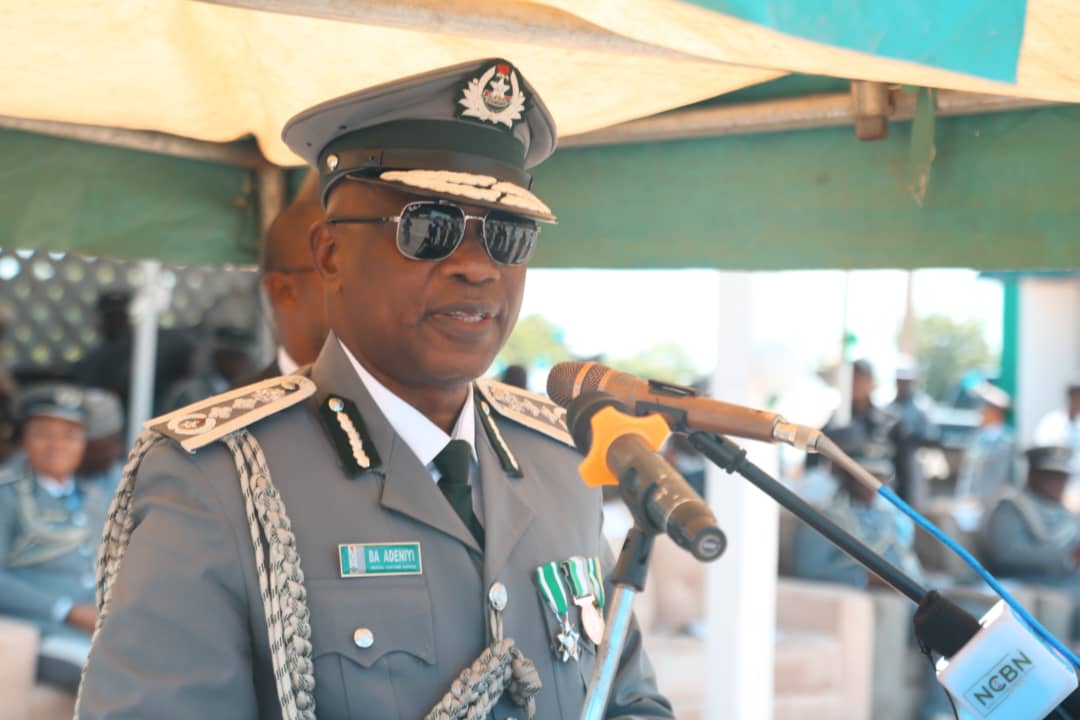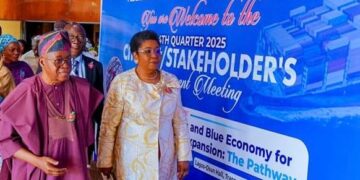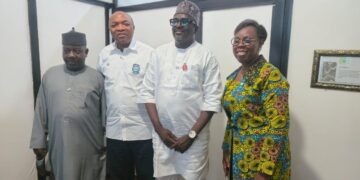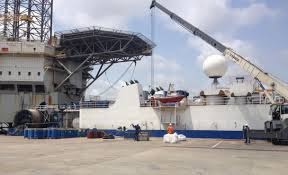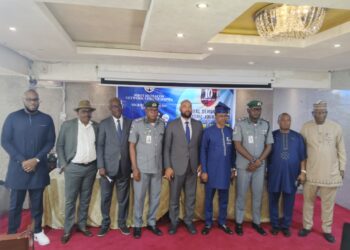After a recent tour of the
Lagos Deep Offshore Logistics Base (LADOL) Free Zone in Lagos, Nigeria, the Nigeria Export
Processing Zone Authority (NEPZA) the government agency responsible for regulating
free zones, affirmed the facility’s quality and standards of operation.
Lagos Deep Offshore Logistics Base (LADOL) Free Zone in Lagos, Nigeria, the Nigeria Export
Processing Zone Authority (NEPZA) the government agency responsible for regulating
free zones, affirmed the facility’s quality and standards of operation.
Managing Director of NEPZA,
Mr Gbenga Kuye, who was touring the
facility for a third time, described LADOL as ‘one of the top free zones’ and that its
operations had earned it the status of an industrial park.
After a tour of the
facility, Kuye said his experience of what he saw superseded his expectation
based on his last visit to the site, while he expressed particular satisfaction
with the level of safety measures in place.
facility, Kuye said his experience of what he saw superseded his expectation
based on his last visit to the site, while he expressed particular satisfaction
with the level of safety measures in place.
“When we came to do the ground-breaking about 15 or 16
months ago, I was not expecting this level of activity, but I believed in the
dream and have given all the support.
months ago, I was not expecting this level of activity, but I believed in the
dream and have given all the support.
“But what I have seen today, not only in terms of what
has been achieved, but in terms of world-class standards of doing things makes
me proud of you.
has been achieved, but in terms of world-class standards of doing things makes
me proud of you.
“This is real work, not make-belief, because as a
chemical engineer, I know when somebody is telling stories, especially when it comes
to coating, painting and fabrication.
chemical engineer, I know when somebody is telling stories, especially when it comes
to coating, painting and fabrication.
“I have been to a facility like this. I think in
Singapore or Poland? It is not this big,
but the kind of safety measure that I see here is actually second to none,”
Kuye said.
Singapore or Poland? It is not this big,
but the kind of safety measure that I see here is actually second to none,”
Kuye said.
On the scope of NEPZA’s responsibility, Kuye said the
agency had grown bigger and so, was in a legislative process of changing its name
from NEPZA to NIDZA, that is, Nigeria Industrial Development Zones Authority, an
agency to be solely responsible for industrialisation.
agency had grown bigger and so, was in a legislative process of changing its name
from NEPZA to NIDZA, that is, Nigeria Industrial Development Zones Authority, an
agency to be solely responsible for industrialisation.
On NEPZA creating enabling environment for
Nigeria’s free zones to thrive, Kuye said the agency always acted readily to
support these operations in terms of
intervening to settle administrative
challenges that might involve any agency of government, to the benefit
of the nation’s economy.
Nigeria’s free zones to thrive, Kuye said the agency always acted readily to
support these operations in terms of
intervening to settle administrative
challenges that might involve any agency of government, to the benefit
of the nation’s economy.
He recalled one of such occasions when
NEPZA had to intervene to settle an issue that LADOL had with the compliance
and enforcement department of the Nigeria Customs Service (NCS) which
eventually made them rescind an order concerning the berthing of a vessel.
NEPZA had to intervene to settle an issue that LADOL had with the compliance
and enforcement department of the Nigeria Customs Service (NCS) which
eventually made them rescind an order concerning the berthing of a vessel.
Kuye said that in another development of ensuring enabling
environment for the free zones, NEPZA again intervened recently to facilitate a
meeting of the LADOL management and the Comptroller-General of Customs to
settle some issues that arose.
environment for the free zones, NEPZA again intervened recently to facilitate a
meeting of the LADOL management and the Comptroller-General of Customs to
settle some issues that arose.
His words: “Last week, also, there were
some issues, and we facilitated the Management of LADOL meeting the CG
one-on-one, even without prior arrangement. When they went there, they had
their meeting, and they came out happy. That, to me, is enabling environment.”
some issues, and we facilitated the Management of LADOL meeting the CG
one-on-one, even without prior arrangement. When they went there, they had
their meeting, and they came out happy. That, to me, is enabling environment.”
Earlier, the LADOL Managing Director, Dr
Amy Jadesimi, said the location of the Lagos Free Zone(LFZ )was an advantage
for the company, and the country in terms of jobs that the location would
enable the industry handle.
Amy Jadesimi, said the location of the Lagos Free Zone(LFZ )was an advantage
for the company, and the country in terms of jobs that the location would
enable the industry handle.
Jadesimi, in her presentation, said that developments
at the LFZ would increase the local demand for fabrication four-fold.
at the LFZ would increase the local demand for fabrication four-fold.
Her words: “Now that we can receive FPSOs (floating
production storage and offloading units), VLCCs (very large crude carriers),
semi-submersibles at our quay in LADOL, that increases demand for Nigerdock,
Dorman Long, AVM, Saipem, etc.
production storage and offloading units), VLCCs (very large crude carriers),
semi-submersibles at our quay in LADOL, that increases demand for Nigerdock,
Dorman Long, AVM, Saipem, etc.
“Because, now, just as they do in other places in the
world – Norway, South Korea, Singapore,
you have a location where the vessels berth, you have a location where the
fabricated pieces built throughout Nigeria are assembled.
world – Norway, South Korea, Singapore,
you have a location where the vessels berth, you have a location where the
fabricated pieces built throughout Nigeria are assembled.
“ And that gives you an advantage, which means that
you can now begin to domesticate these projects. Not just 10, 15, 20 per cent,
but even 70 per cent. And 70 per cent domestication is what Brazil has. That is
one of the things that drove Brazil to join the G20.
you can now begin to domesticate these projects. Not just 10, 15, 20 per cent,
but even 70 per cent. And 70 per cent domestication is what Brazil has. That is
one of the things that drove Brazil to join the G20.
“During
our development, we had the support of the United States Trade and Development
Agency (USTDA) in our power, in our electronic management system, and, as we
developed from a swampland into the $600 million facility you see today, we
always bore in mind the fact that we wanted to do something that hadn’t been
done before.
our development, we had the support of the United States Trade and Development
Agency (USTDA) in our power, in our electronic management system, and, as we
developed from a swampland into the $600 million facility you see today, we
always bore in mind the fact that we wanted to do something that hadn’t been
done before.
“And that wasn’t just building a facility; it was
operating it in a way that made us more efficient than a lot of yards in the
West. A lot of yards in the West were built 30, 40 years ago,” she said.
operating it in a way that made us more efficient than a lot of yards in the
West. A lot of yards in the West were built 30, 40 years ago,” she said.
Jadesimi said their operations would be mainly
IT-driven (Information Technology) working in a cashless and paperless system,
which was what the USTDA helped them develop.
IT-driven (Information Technology) working in a cashless and paperless system,
which was what the USTDA helped them develop.
She added that besides helping to lower cost, the
system would enable them achieve increased efficiency and work accuracy, which
is the idea behind the right operational system and having the right training
facilities.
system would enable them achieve increased efficiency and work accuracy, which
is the idea behind the right operational system and having the right training
facilities.




